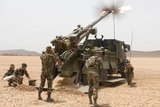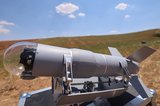DARPA’s MFP to counter small UAS
DARPA has awarded Phase 1 agreements for its Mobile Force Protection (MFP) programme to three teams led by Dynetics, Saab and SRC, the agency announced on 21 August.
The MFP programme aims to develop real-time protection for ground and maritime convoys by advancing technology to quickly neutralise hostile small UAS.
Hostile, small UAS are a challenge of increasing concern for the US military. Countering the threat they pose to land and sea convoys in real time requires a range of technology advances to enable their rapid detection, identification, tracking, and neutralization. MFP aims to achieve these goals by developing scalable, modular and affordable approaches that could be deployed within the next three to four years and evolve with advances in threats, tactics, and technology.
The three teams will work to integrate novel ideas for advanced sensors and neutralisation approaches into a common framework emphasizing safety for civilian bystanders, ease of operation, and low size, weight, power, and cost. The goal is a technology demonstration system that could by integrated with current tactical ground vehicles and maritime vessels.
To speed development DARPA has selected the US Army’s Maneuver Aviation and Fires Integration Application (MAFIA) service-oriented architecture as the common framework for the data-fusion engine, decision-aid algorithms, and user interface, as well as the backbone for the teams’ command and control software.
MAFIA is already in the field supporting multiple operating systems and has the required capability to enable an envisioned plug-and-play system capable of integrating new sensors and emerging technologies.
The MFP programme will have three phases, with the timeline currently aiming for a technology demonstration system to show initial functionality at the end of phase one and progressively improve, culminating in a full-capability demonstration on a moving vehicle or vessel by the end of phase three.
At the conclusion of each open-air demonstration, DARPA will offer the military and government agencies the opportunity to fund extended field evaluations, with the goal of developing the interim versions and the final prototype system to meet the needs of a broad number of potential US government and commercial users.
More from Land Warfare
-
![Land forces review: howitzers in the spotlight and Germany spends big to close the year]()
Land forces review: howitzers in the spotlight and Germany spends big to close the year
December saw several milestones on the howitzer front with billions of dollars worth of orders placed and Germany committing to more 6×6 and 4×4 vehicles. Taiwan was also approved for equipment orders worth $11 billion even as the year came to an end with China encircling the country as part of an exercise.
-
![Supply of new self-propelled guns is rising to meet looming demand]()
Supply of new self-propelled guns is rising to meet looming demand
As the need for self-propelled artillery continues to climb across Europe and NATO-allied nations, orders for existing capabilities continue to roll in while new and improved weapons are on the way.
-
![US Army seeks industry support to prepare acquisitions of Group 4+ UAVs]()
US Army seeks industry support to prepare acquisitions of Group 4+ UAVs
The US Army is keen to hear about vendor designs, strategies and potential hardware and software solutions to inform requirements for procurement efforts.
-
![Dedicated drone munitions could unlock modular mission potential]()
Dedicated drone munitions could unlock modular mission potential
Top attacks have proven effective against heavily armoured vehicles in Ukraine. A new family of uncrewed aerial system-delivered munitions is looking to press that advantage further.
-
![Elbit bets on local content for US howitzer bid as it faces off against popular systems]()
Elbit bets on local content for US howitzer bid as it faces off against popular systems
The Israeli company hopes that producing its Sigma artillery system wholly in the US will help it win a key US Army contract, but it will be up against the popular CAESAR Mk II wheeled weapon and the K9 tracked.
-
![Germany orders 84 Boxer howitzers as UK commits to a single demonstrator]()
Germany orders 84 Boxer howitzers as UK commits to a single demonstrator
Germany has ordered 84 RCH 155 self-propelled guns, as system incorporating Boxer 8×8 vehicles and the Artillery Gun Module, and 200 Puma Infantry Fighting Vehicles while the UK has committed to a single Early Capability Demonstrator RCH 155.

























